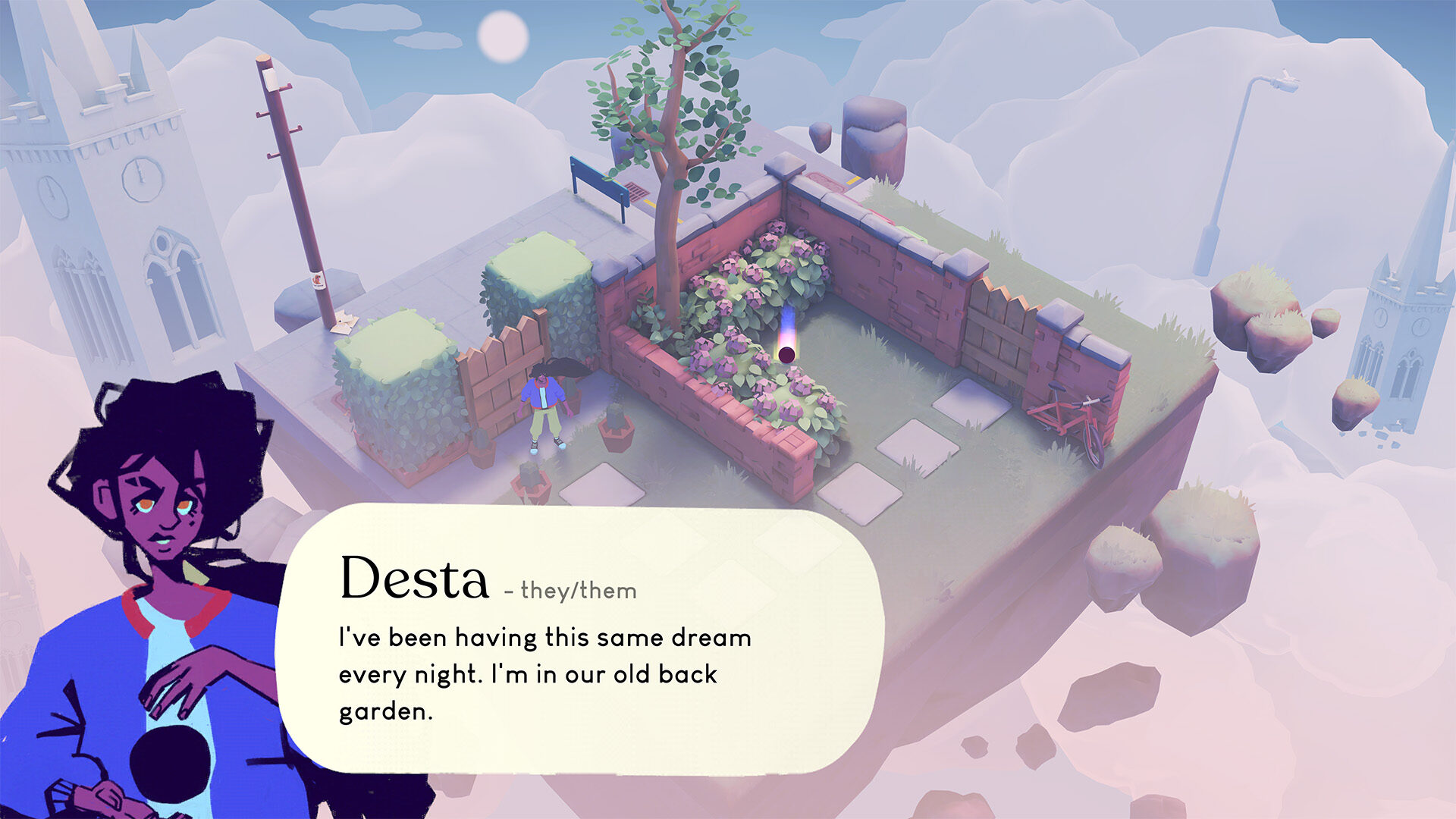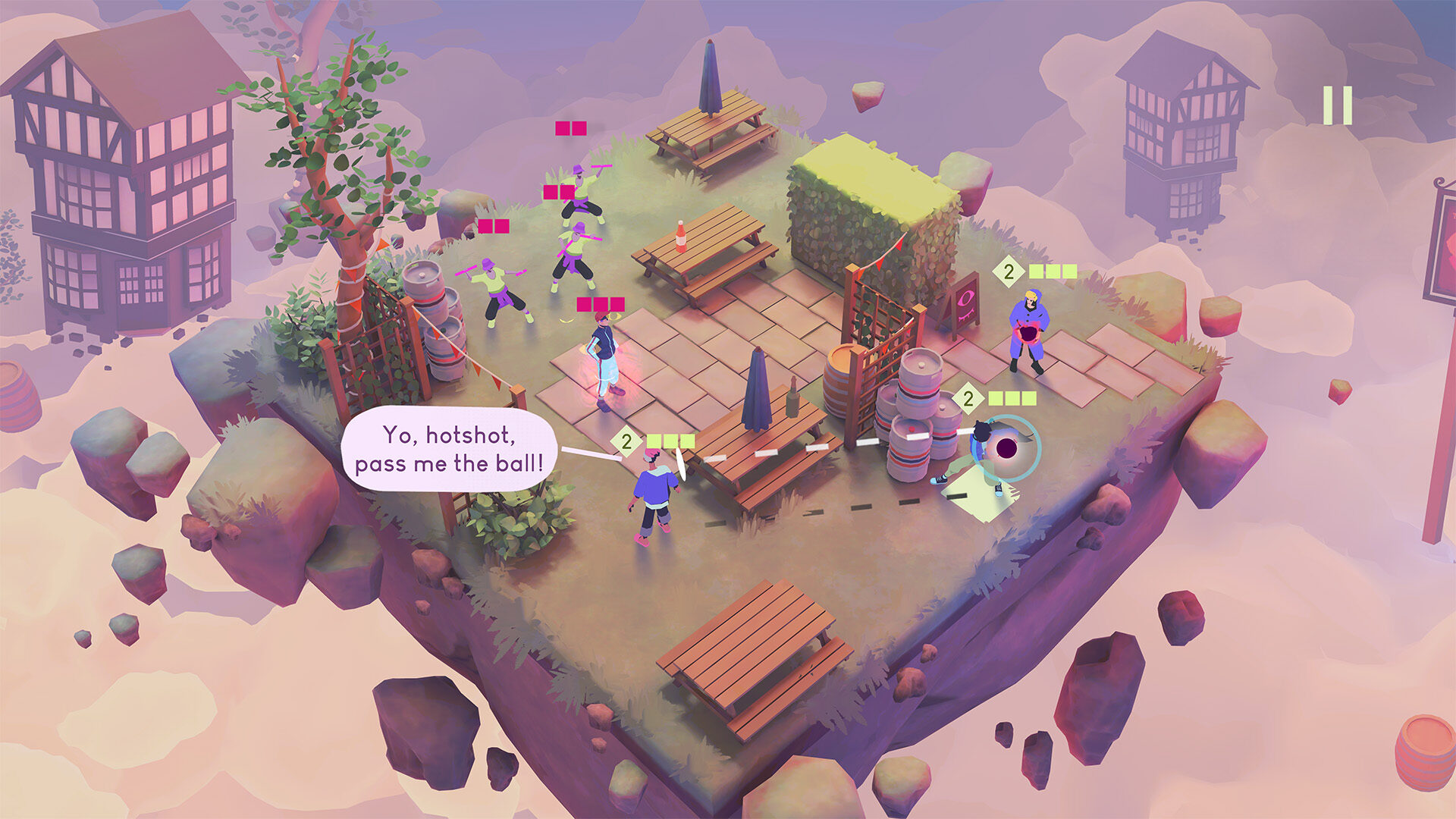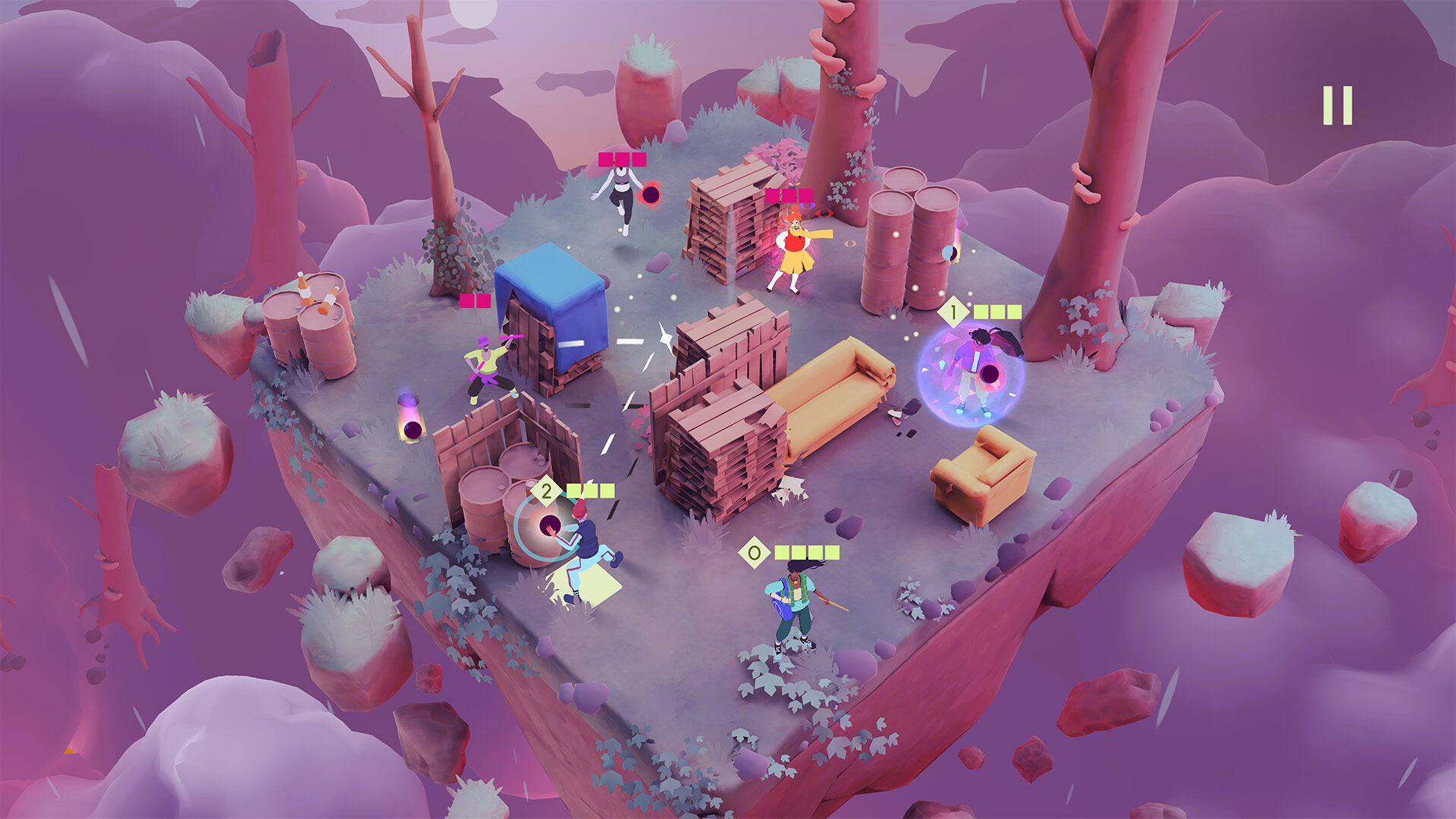If you were trying to use the usual genre labels to sum up Desta: The Memories Between, the latest from Monument Valley creators ustwo Games, the closest you could get would be “narrative-driven, turn-based, tactical dodgeball roguelike.” Needless to say, that’s not exactly a tired combo—even if Desta does stumble a bit in making the most of its originality.
Centered on a young adult named Desta returning home to a small town in England, Desta is set in its protagonist’s dreams, as they confront their anxieties about people they used to know back home: old flames, out-of-touch friends, and most crucially, their mother, with whom they’ve become estranged since the death of their father. These confrontations come in the form of dodgeball matches in dreamscape versions of real-world locations that are important to Desta, because, well, it’s still a video game, isn’t it?
The narrative side of Desta comes packaged in the 2D-character-art-and-textbox style of a visual novel, with fully voice-acted (but non-branching) conversations between Desta and imagined, dreamworld versions of their friends and family. It’s far from deep—even with a few alternate dialogue lines for repeat visits, and new conversations that unlock when you level up teammates, there’s just not a ton of dialogue here. Light on plot or big revelations, it’s a relatively low-stakes, shallow exploration of a young person’s psyche, aiming to reflect and refract anxieties we’ve probably all struggled with at some point. Still, there’s a gentle humanity and optimism underlying the story that’s refreshing, and the voice acting and writing do a fair job of rounding out Desta’s eclectic batch of characters in spite of limited screen time.

As you may have picked up on from the they/them pronouns, Desta is nonbinary, but this isn’t a story about coming out or self-discovery or struggling with gender identity. While one chapter in the middle of the game does revolve around Desta’s anxiety about finally telling one of their friends, you’ve already gotten to know them in many other contexts before this point. I don’t have the lived experience to be any kind of arbiter of respectful or accurate portrayals of gender identity, but I can say the game’s worked well for me. Desta’s identity is one of many things about them, not ignored or invisible but also not given any kind of blaring, five-alarm centrality to their character.
By total time, if not by importance, the narrative does take a backseat to what I guess you’d call “combat.” This is certainly the most traditionally gameplay-focused experience ustwo has ever released. You beat levels to get to bosses, and once you beat a boss they join your roster as a party member you can use during future fights. While it plays much like a standard tactics game—you take turns with the AI moving characters on a grid and attacking—it’s clear a great deal of thought has gone into twisting the genre into something a bit new and a bit more accessible than you might expect.
On the novelty front, the dodgeball idea is something of a subtle revolution. For starters, it gives every match a clear and concise logic. You can only attack if you’re holding a ball, so right away you know exactly where you should move your characters: where the many balls spawn at the start of each level. Though some later enemy units can attack directly or summon their own balls to toss, the general sense is that offense is the same as defense here. Any ball you pick up is also a ball that your opponents can’t toss back at you. And since each character has two actions per turn, by default, there’s a natural rhythm—pick up a ball, throw a ball—that conveys clearly in the early stages, before things start to get a bit more complicated.
Attacking also has a few neat wrinkles. Rather than relying on randomization or hit percentages, Desta: The Memories Between instead lets you drag behind a character to toss the ball, with a dotted line showing its trajectory for a certain distance. If you’re close enough, you can know with certainty whether or not your throw will hit, even if it has ricochets on the way there. It’s an Angry Birds level of accessibility that naturally expands to encourage bigger risks as you get better at the game. You can land shots from much farther away than the dotted line indicates, especially if you time the release right for maximum power. Eventually, through circumstance and familiarity, you’ll outgrow the training wheels.

Better still, since you can take the actions of any teammate in any order, you can actually get into deeper tactical decision making using the deceptively simple system. Maybe your best bet is actually to have one character run to the ball, pass it to a second character, and then have that second character pass it to a third to land the attack. And if you carefully manage the ricochet, you can also ensure your attacks will bounce the ball back to someone on your team, passing and attacking in a single action.
Desta has one more trick for deepening gameplay, and it comes in the form of some light roguelike elements. Desta has a slot for one active and one passive ability, but what you can equip here is randomized per run, with options added to your inventory at selected points throughout the story. Maybe you’ll have an ability that can lock an enemy you target in a cage for a single turn, skipping their actions. Or maybe you can spend one of your actions to power up the ball you’re holding so you can do double damage with your next throw. Passives can be particularly powerful in the right circumstances, granting bonus damage for shots that ricochet before hitting an opponent or adding an extra hit for each ally standing next to Desta when they throw.
For a company that’s diving into tactics gameplay for the first time, ustwo has done a solid job here, both in terms of exploring neat ideas and in making it all feel natural on a touchscreen. Even on my phone—I don’t actually own a tablet for crotchety old man reasons we don’t need to get into—everything looked and played great. Aiming on a small screen can occasionally feel a bit fidgety, but I only whiffed a few shots, and I think I’d probably have opted for portability even if I had the option of playing on a tablet.
So, to be clear, there’s a lot of good in Desta. What lets the game down, ultimately, is not that its gameplay mechanics or story are poorly imagined, but that they’re deployed in service of a structure that doesn’t make the most of them. Once you’ve reached the end credits, you probably know enough and have powered up your characters enough to beat the story at will as many times as you want. But that’s all there really is to do—to replay the same 70-odd minutes of content over and over again with different teammates and abilities.

What’s kind of baffling, though, is that since the order in which you unlock teammates is always the same, you can’t actually focus on leveling up specific ones until you’ve progressed that far in the story. The final character unlocks right before the final boss battle, so if you want to max out your roster, you’ve eventually going to get to a point where you’re playing the entire game making no progress for 95% of your playtime. And even then, you’re working toward maxing out a character that you can only have on your team for one fight.
If Desta did play more like a conventional roguelike, with procedurally generated encounters, randomized allies, and a quicker ramp-up into challenging content, I imagine it would be a ton of fun to revisit over and over to max out everything, especially if there were some sort of endless challenge mode. So many of Desta’s parts feel designed with that kind of game in mind, but they’ve been bolted onto a linear narrative structure where they make no sense. The toys don’t fit in the toybox.
Look, ustwo has framed Desta as the studio’s first live-service game, so it’s entirely possible that alternate modes that will make better sense of the progression and offer more to do than just play through once are already in the works. Maybe what I played for review will one day be seen as a first draft of a great game.
In this sense, ustwo’s release plans, which have the game starting life on mobile as a free exclusive for Netflix subscribers, with other platforms coming down the road, may work to its benefit. If you’re not paying a dime to try out the game, you’re liable to be a bit more forgiving of its shortcomings. And perhaps by the time players will need to pay, ustwo will have had a chance to more fully flesh out the experience to deliver on its potential.
As the game exists today, I’m not saying that you won’t have a decent time getting to the end credits, or that you won’t be charmed by the characters and a little touched by the story. I just think it’s important to note that, on a conceptual level, “narrative tactical dodgeball roguelike” is a big, weird, great promise for a game to make. But Desta: The Memories Between, like its protagonist, isn’t quite confident enough to bring its dreams into the real world just yet.
|
★★★☆☆
Desta: The Memories Between can’t quite figure out how to make the most of its odd genre mashup. Though the individual elements are solid, a lack of commitment to roguelike randomization in the single mode available at launch means the systems don’t really mesh together how you’d expect, and the replay value suffers as a result. |
Developer ustwo Games Publisher ustwo Games, Netflix ESRB RP - Rating Pending Release Date 09.26.2022 |
| Desta: The Memories Between is available on iOS, Android. Primary version played was for Android. Product was provided by ustwo Games, Netflix for the benefit of this coverage. EGM reviews on a scale of one to five stars. | |
